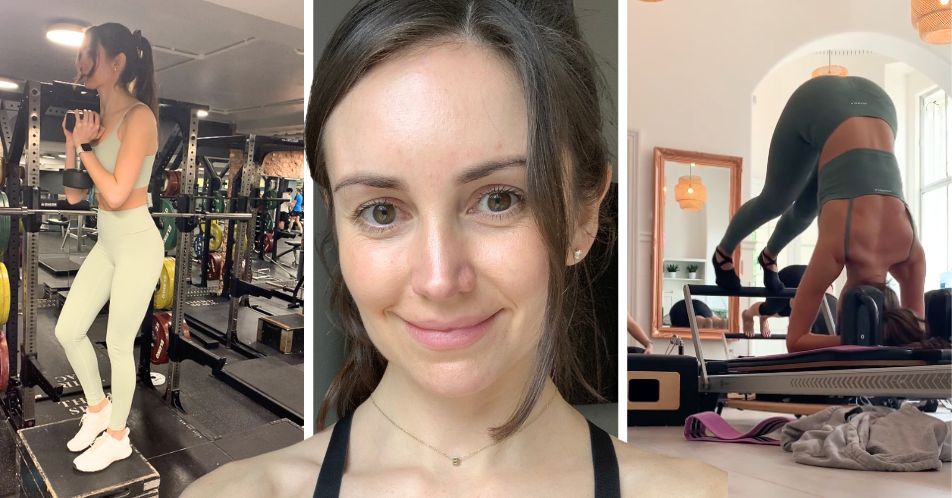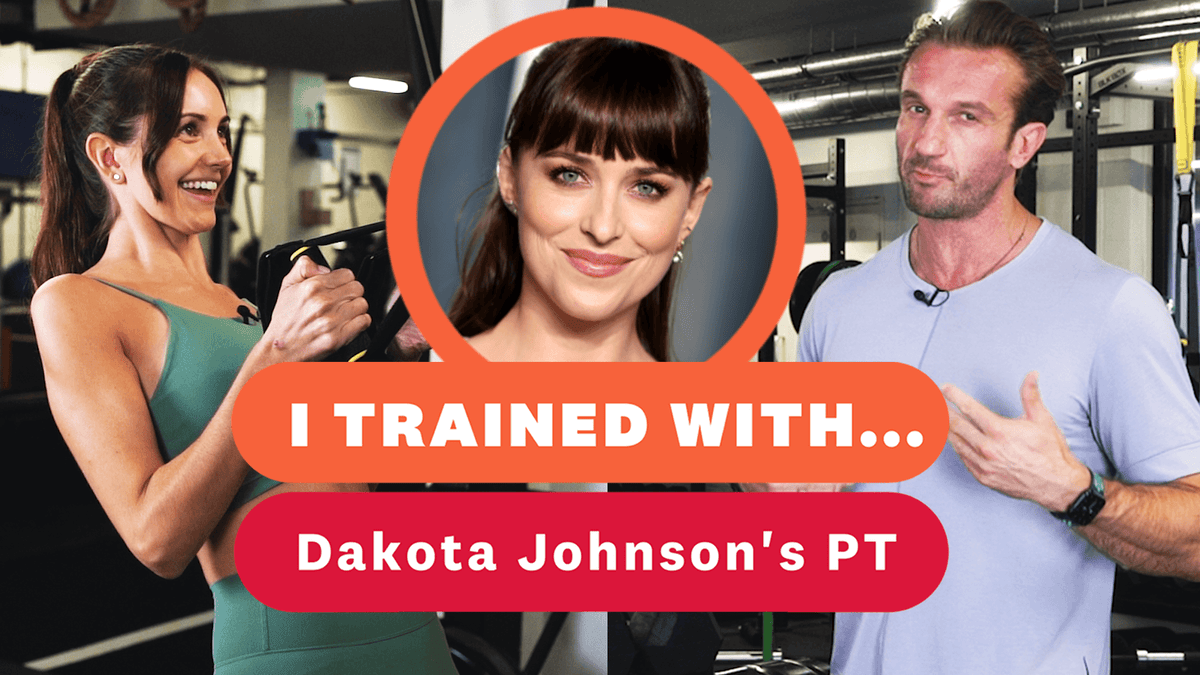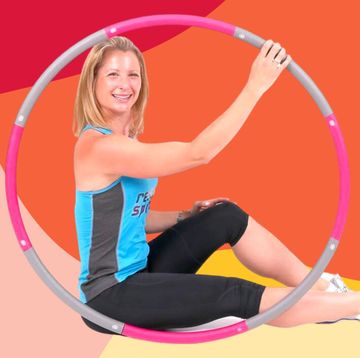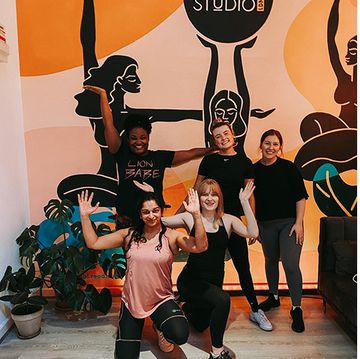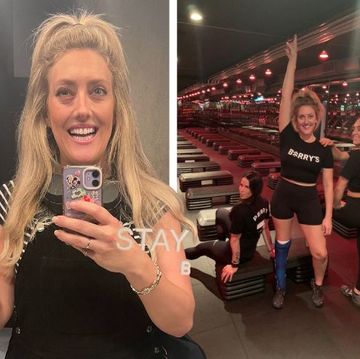Humble brag: I reckon I could spot a fitness gimmick a mile off. As WH’s Fitness Editor, I spend pretty much all day everyday reading/writing about the latest workout trends. I’m also kind of addicted to TikTok, which is where I came across the 12-3-30 workout, the 25-7-2 Stairmaster workout and, case in point, the 3-2-8 barre Pilates method.
Search ‘3-2-8 workout’ on TikTok and you’ll see it’s had 292.2 million views so far, with users making big claims such as ‘it’s completely transformed my body,’ ‘the 3-2-8 method helped reduce my cortisol belly and control my hormones,’ and ‘I healed my hormones, reduced inflammation and dropped 14lbs.’ Don’t get me wrong, I know these are some vvv bold statements, but with so many people posting about it I decided to do some digging.
Marsha Lindsay (Pilates by Marsha), Founder of Nobu Pilates and a leading Pilates instructor gives it the green light, telling me it’s a ‘very safe regime, so long as you’re progressing safely and gradually and seeking expert advice on form.’ So, with her approval in mind, I set about doing the 3-2-8 barre Pilates method for 30 days. Here’s what happened, and everything you need to know about the trend.
What is the 3-2-8 barre Pilates method?
The method is, essentially, a workout plan. The premise is simple:
- 3 strength training workouts per week
- 2 Pilates or barre workouts per week
- 8,000 steps a day
Alternatively, you could do:
- 2 strength workouts per week
- 3 Pilates or barre workouts per week
- 8,000 steps a day
It was founded by Natalie Rose, a UK-based Pilates and barre instructor and owner of the virtual Body by Barre Studio. She first posted about the 3-2-8 plan in December 2022, captioning the vid: ‘My not-so-secret method that will leave you feeling snatched and strong.’ She added: ‘In 6 weeks you will feel it, in 8 weeks your family and friends will ask for tips, in 12 weeks you will be transformed.’
In another clip, Natalie adds the following detail:
- ‘You can do your workouts at the gym or at home’
- ‘You want to progressively overload the intensity of your workouts (adding weight to your exercises) every four to six weeks’
- ‘You should include compound exercises in full-body weight workouts, and you can split your weighted workouts into full-, lower and upper-body sessions’
- ‘Do Pilates and barre on active recovery days to reduce inflammation, improve mobility and improve deep core and pelvic strength, and for lymphatic drainage’
- ‘Do 8k steps per day to help burn visceral fat’
She also bills the plan as ‘PCOS friendly’, with plenty of her vids touting the benefits for those who suffer with PCOS (polycystic ovary syndrome). Exhibit A:
The mention of PCOS rings a few alarm bells with me. Granted, there have been studies into the pros of both strength training and Pilates for improving PCOS symptoms, but one study in Baltimore's Medicine Journal found that overdoing exercise for PCOS in general could make your menstrual cycle even more irregular.
This is mainly down to a spike in cortisol levels (that can stick around and become chronic if you continue to overtrain on a long-term basis), which puts your hormones out of whack. The 3-2-8 method seems pretty full on, with five workouts per week + 8k steps per day, and as exercise medicine consultant Dr Rebecca Robinson tells me, ‘Overdoing it could cause the loss of periods due to a negative energy balance, or worsen symptoms by throwing your hormones further off balance.’
What's more, studies have shown that just 30 minutes of exercise a day, three times a week, to three total hours per week can improve metabolic and reproductive symptoms associated with PCOS.
All that said, the 3-2-8 barre Pilates plan doesn’t specify workout durations, so while five workouts per week might seem overwhelming, you can make them as short as suits you.
8 benefits of the 3-2-8 method
1.It’s well-rounded
According to the NHS, adults should do ‘strengthening activities that work all the major muscle groups on at least 2 days a week,’ and a total of ‘at least 150 minutes of moderate intensity activity a week or 75 minutes of vigorous intensity activity a week’. Providing your workouts are long enough, the 3-2-8 method ticks both of these boxes.
Marsha concurs: ‘The 3-2-8 method is a well-rounded fitness routine that covers all the big muscle groups, and the inclusion of Pilates and barre will help you achieve the small/deeper muscle connection.’ This will help you perform the bigger compound exercises in your workout routine more effectively.
For example, this study compared a group of people with Pilates experience with those who had very little. The group who had more Pilates experience were more able to activate their core muscles and stabilise their pelvis and therefore, perform exercises more accurately and effectively.
2. It instils consistency
Studies have shown that consistency is more important than the duration of your workouts when it comes to results and this is exactly what the 3-2-8 method is all about. ‘It’s all about sticking to your regular workouts, and can help create new habits,’ says Marsha.
3. It highlights the importance of recovery
Though you’re right in thinking that five workouts per week (plus 8k steps per day) is a lot, the 3-2-8 plan does dedicate specific days to ‘active recovery’ (when you are advised to do your barre or Pilates workouts), and includes two complete rest days per week. ‘Regeneration is just as necessary as training to safeguard your body against injury and improve your ability to work harder the next time you train,’ Marsha advises.
4. It can be scaled for all fitness levels
As mentioned, the duration of each workout in the plan can be adapted to suit you, and this can be changed as and when you feel like it. The intensity of your workouts is also entirely up to you; you may well choose to make your strength workouts bodyweight one week, or with the heaviest weights that you can. Likewise, you can select whichever exercises you prefer, depending on your experience and/or which you enjoy (I will not be including burpees, thank you).
‘The 3,2,8 method is a pretty attainable regime for most,’ says Marsha. ‘This could be very appealing for those who are time poor and find it challenging to fit fitness into their life. You can look at your week and work out how to slot workouts into your schedule. For example, you can change the duration of time you’re spending on each whether it’s 20 mins, 40 mins, or an hour. Consistency in doing the regime as per the number of days is sometimes more important than the duration of time on each. Habits are built and cemented with repetition and consistency; over time you can work on expanding the duration of the session.’
5. It doesn’t require any equipment
The strength workouts in your 3-2-8 plan can be weighted or bodyweight, and Pilates workouts can include some kit (think Pilates balls, Pilates rings and resistance bands), or nothing at all. A big bonus in the #costoflivingcrisis.
6. It can help you build strength
Strength training encompasses everything from weightlifting to Pilates, and both have been proven to increase muscle mass. Science has also proven that active recovery and rest days (both of which are implemented in the 3-2-8 plan) are essential for muscle recovery as it gives them the time they need to sew themselves back together, then grow back stronger (a process known as hypertrophy).
7. It can improve flexibility
Several studies have shown that Pilates can help you improve your flexibility and mobility. One even proved that you ‘can improve your muscular endurance and flexibility using relatively low-intensity Pilates exercises that do not require equipment or a high degree of skill and are easy to master and use within a personal fitness routine.’ Go figure.
8. It can improve body composition
Muscle is more metabolically active at rest than fat. This means that by increasing your muscle mass through the strength training element of the 3-2-8 plan, you could burn more calories and fat at rest.
3 cons of the 3-2-8 method
1.It doesn’t reference nutrition
You may have heard the adage that ‘you can’t out-exercise a bad diet’. It’s true that a combo of exercise and nutrition is essential if you’re looking to improve your body composition or change your body, but the 3-2-8 plan doesn’t include any mention of nutrition.
This is something Marsha picked up on, too. ‘The 3-2-8 method suggests that you’ll be able to change your body and how you look by exercising alone, but nutrition is essential if your desired goal is based on body composition or weight loss.’
2. It doesn’t incorporate cardio
Perhaps the biggest pitfall of all, is that the 3-2-8 method doesn’t include any form of cardio workout. Now, depending on how you structure your strength training and Pilates workouts, these may well veer into cardio territory (if you limit your rest time and choose high reps over high weight, for example), and you may well decide to rack up your 8k steps a day by including a speed walk, but without doing so you may not be giving your heart the exercise it needs.
‘Various studies have proven the importance of good cardiorespiratory fitness to maintain a healthy heart,’ says Marsha. ‘It could be a good idea to swap out one of your Pilates/strength training workouts for a run or cycle.’
3. It promises unattainable results
We’re all for sustainable routines over quick fixes here at WH, so we’re not a fan of the timings given for achieving results through the 3-2-8 plan. It claims that ‘In 6 weeks you will feel it, in 8 weeks your family and friends will ask for tips, in 12 weeks you will be transformed.’ But there isn’t, and never has been, a one-size-fits-all approach to fitness. It’s impossible to say that everyone who does the plan will see results in the same timeframe as everyone else.
How to incorporate progressive overload in the 3-2-8 plan
Founder of the plan Natalie advises ‘progressively overloading’ every four to six weeks, here are Marsha’s tips for doing so.
1.Increase your reps: ‘Once you have formulated your initial programme, start using it consistently on the same days if you can. For example, do leg day every Monday. This is the best way to manage any external variable that could affect your performance and you can truly monitor your body’s progression. Maintain the same weight for 2-4 weeks, then after four weeks, consider increasing the repetitions. Add 4-6 reps to each set.’
2. Increase your load: ‘After you have increased your reps, you may feel the work is getting easier 2-4 weeks in. When this time comes, it's time to increase the weight. Up the weight by 10-20% (go for the lower percentage if you’re unsure), then decrease your reps to the original number you started with. Use this as a cycle that you monitor and refresh every 2-4 weeks.’
3. Increase your duration: ‘It’s important to also improve your endurance, and you can do this by increasing the amount of time you’re working out, from a 30-minute session to 40 minute.’
What is the difference between barre and Pilates?
Natalie gives the option between barre and Pilates workouts within the 3-2-8 plan; I stuck to Pilates throughout my challenge, purely because I prefer it to barre, but you can find free workouts for both on YouTube. Here’s a handy definition of each, courtesy of Marsha.
- Barre was formulated and inspired by ballet strength conditioning, so whilst it’s a great workout, it’s more about isolating certain muscle groups in each move.
- Pilates focuses on integrating all of the muscles to switch on simultaneously during each move; essentially you will cover more bases effectively in one session.
So, is the 3-2-8 method safe?
Yes. ‘So long as you’re progressing safely and gradually, listening to your body's needs, and you are seeking expert advice on form, then this is a safe regime,’ Marsha concurs.
What happened when I did the 3-2-8 method for 30 days
1.3 strength workouts per week is not the one for me
About a week in, I genuinely felt like I was going to die from exhaustion (dramatic? Me?). One of my biggest weaknesses is that if I’m going to do a workout, I’ll go all-out (would not recommend – I’m working on it), and my strength training workouts were killing me off.
So, on day six, I changed from three strength workouts per week to two. Upon asking Marsha whether I’d be less likely to see results (both mental and physical), she reassures me: ‘No, you need to assess what’s best for you. A more frequent Pilates and barre balance may work better for you individually. This can be for aesthetic reasons, energy levels, how your body best gets its endorphins etc. So no, it’s not necessary to stick to three strength workouts if you aren’t feeling the positive effects, and you should definitely manipulate the regime to suit how your body responds positively or feels safest in the method.’
I also reduced the intensity of my strength workouts. I’d started the plan by lifting the heaviest weights I could, but after week one, I cut back to one bodyweight workout and one just one weighted workout. I managed to keep the weight fairly heavy from this point onwards, but there were two or three times when I opted for lower weight and higher reps, when I wanted to get a bit sweatier.
2. Morning workouts are way easier
Throughout the whole 30 days, I found doing every element of the plan: strength workouts, Pilates workouts, and walks, a ton easier in the morning than in the evening. I know that, for some people, it’s the opposite; they prefer to train in the evening as it helps them to destress from a day of work, but I have just about enough energy to cook dinner, let alone head to the gym. Marsha tells me this isn’t uncommon.
‘Your energy levels in the morning are at their peak, as you are well rested and regenerated from sleep. This means you have replenished energy reserves, are more alert and have greater stamina to get through your workout. You are both mentally and physically raring to go in the mornings.
‘However, I like to mix it up with both. This is mainly due to scheduling restraints, but I also find evening workouts (particularly Pilates) will help to cleanse my mind from the day's events and help me to sleep deeper.’
Find what works for you – I’ll be sticking to morning sessions, but you might be a Marsha.
3. I find it easier to stay motivated for group classes than individual workouts
I did every Pilates workout in a group setting, at my local reformer Pilates studio Power Pilates in Beckenham, and every strength workout on my own, either at the gym or at home. I’d count down the days until my next Pilates class, but there were a few occasions where I’d have to really force myself to do my strength workouts. This is quite unlike me – if you’ve read my weightlifting journey, you’ll know I love training, but sometimes I really need to push myself. Marsha tells me that exercising a group session is easier for most people.
‘You feel a sense of accountability, morale and an extra boost to perform and push yourself harder,’ she explains. ‘On top of this, there can be an element of fun in exercising with company, combined with the fact you are in a space where you can trust that an instructor will guide you thoroughly and safely. Sometimes working out solo in the gym you can get lost, distracted, or feel unsure of what you’re doing. Mix this with the tendency to watch the time (which you don’t get to do in a good class), it can lead to solo workouts being dull for some.
'To stay motivated in individual workouts, there are so many apps and platforms that you can use to boost morale and keep you on track. Also, try to switch your mentality and view the sessions as a time to focus on yourself and your own body, which you rarely get to do in the day.’ Some very wise words, and it works a treat. I download WeGlow – an app founded by super trainer Stef Williams and find it much easier to stick to my routine.
Have a browse of our edit of the best fitness apps to find one to suit you.
My results
I didn’t go into the plan with an aesthetic goal in mind, but I have noticed one huge change: my posture. I’ve been doing reformer Pilates weekly for almost two years (mat Pilates can be just as effective for results, if this isn't an option for you, FYI), but after ramping it up to three times, I am genuinely surprised by how much taller I’m standing and the reduced roundness in my shoulders.
‘Pilates isn’t intended for you to see weight loss or drastic change,’ Marsha tells me. ‘It contributes to your core strength and foundation which can have huge benefits for your posture and strength.’ Even my boyfriend, who likes to call me the Hunchback of Notre Dame when I sit hunched over my desk, has commented.
Will I keep it up? Elements of it, yes. I’ve loved doing 8k steps per day and have found it easier to sustain than the 10k steps we all believe to be the ‘golden number’, so I’ll definitely aim to keep this in my routine. I’ll also be maintaining a combo of strength and Pilates workouts. This is something I’ve naturally done for around two years since strength and Pilates are my favourite forms of exercise (the workout you enjoy is the one you’ll stick to, after all), but I certainly won’t be maintaining the frequency of workouts.
As mentioned, three strength training sessions isn’t sustainable for me energy-wise, and a total of five workouts per week is also very ambitious. I work 9-5pm, plus three hours of commuting per day, twice per week, and I’m also in the middle of moving house and planning a wedding (props to anyone who actually has time for a social life/housework). I probably could fit in five shorter workouts if I tried, but I like to set aside at least 45 minutes for a session so that I can include at least a 10-minute warm-up and cool-down.
The bottom line: the 3-2-8 method definitely has its pros, but there is no such thing as a perfect workout routine. Pick the parts of the plan that suit you and run with that.
